Precious Metals
Since the dawn of time, gold and silver have been recognized as valuable. And even today, precious metals have their place in an intelligent investor's portfolio. But which precious metal is best for investment purposes? And why are they so volatile? If you're just getting started in precious metals, read on to learn more about how they work and how you can invest in them. There are many ways to buy into precious metals like gold, silver and platinum and a host of good reasons why you should give in to the treasure hunt.
What are Precious Metals?
A precious metal is a rare metallic chemical element of high economic value.Chemically, the precious metals are less reactive than most elements, have high luster, and have higher melting points than other metals. Historically, precious metals were important as money, but are now regarded mainly as investment and industrial commodities. Gold, silver, platinum, and palladium each have an ISO 4217 currency code.
The best-known precious metals are gold and silver. While both have industrial uses, they are better known for their uses in art, jewelry, and coinage. Other precious metals include the Platinum Group metals: ruthenium, rhodium, palladium, osmium, iridium, and platinum, of which platinum is the most widely traded.
The demand for precious metals is driven not only for their daily use, but also for their role as investments and a store of value. Platinum is the most expensive of the precious metals now, but rhodium once traded higher than $5000 per ounce.
Bullion Precious metals in bulk form are known as bullion and are traded on commodity markets. The defining attribute of bullion is that it is valued by its mass and purity rather than by a face value as money.Bullion metals may be cast into ingots, or minted into coins. Many nations mint bullion coins, the level of purity varies from country to country, with some bullion coins of as pure as 99.99% available. Note that a100% pure bullion is not possible, as absolute purity in extracted and refined metals.
Gold as an investment and silver as an investment are often seen as a hedge against both inflation and economic downturn. Silver Coins have become popular with collectors due to their relative affordability, and unlike most gold and platinum issues which are valued based upon the markets, silver issues are more often valued as collectables, far higher than their actual bullion value.
A metal is deemed to be precious if it is rare. The discovery of new sources of ore or improvements in mining or refining processes may cause the value of a precious metal to diminish. The status of a "precious" metal can also be determined by high demand or market value.
Reasons to Own Precious Metals Now
Expert Advice
Investment experts have long-recommend portfolio diversification and that 10% to 20% (and sometimes more) of an investor's assets be devoted to tangible assets such as gold, silver and platinum bullion and bullion coins. That's prudent asset diversification strategy at any time. But in today's uncertain radical and economic situation, there are many reasons to consider investing in precious metals now. Here are three:Precious Metals Have Been a Solid Hedge Against A Declining U.S. Dollar
The value of the U.S. Dollar declined more than 30% from 2001 through 2004, plunging 5% in just a few weeks. For a long list of reasons, including massive increases in U.S. government deficits totaling trillions of dollars, the cost of a prolonged war against terrorism, and a massive trade imbalance, this trend may be just the beginning. This means U.S. Dollars could now be worth less and less every day. Gold, silver and platinum, though, are held and traded throughout the world . . . and their true value (that is, their purchasing power) is not solely or directly dependent on the falling fortunes of the U.S. Dollar. Precious metals, therefore, can be a form of protection against a falling U.S. Dollar. As demonstrated during the last few years, as the value of the U.S. Dollar declined gold and silver prices and the value of precious metals expressed in dollars increased.Precious Metals Have Been a Proven Safe-Haven in Times of War, Political Strife and Uncertainty
Today's financial markets are increasingly at risk from terrorism, political instability and war. As we saw so clearly after the 9/11 tragedy, financial markets can be closed down, and remain closed down, for extended periods of time. As terrorism incidents continue to increase around the world, it is not unreasonable to expect furtherdisruptions in financial markets, banking and commerce in the future. And today, even in our high-tech driven twenty first century, the asset class millions rely on in times of trouble is gold and silver. Precious metals have always been, and likely will continue to be, a valued form of wealth insurance in good times and bad.Precious Metals Can Offer Outstanding Price Appreciation and Profit Potential
After the infamous stock market bubble in early 2000 wiped out trillions of dollars of investor equity, many stocks have failed to return to anywhere close to their previous highs. The recent dramatic bull market shares some striking similarities to the late nineties. Gold and silver prices, on the other hand, have increased dramatically - more than 40% - during that same time period. Which means precious metals can produce impressive investment returns even when returns from stock, bond and other paper investments decline in value or evaporate completely. And many financial experts have predicted and continue to forecast rising gold, silver, platinum, and palladium prices in the years ahead.Uncertainty in the Markets In our uncertain world of the 21st century, the whims and fancy of a select few can quickly alter the economic safety, control and order we have come to expect and take for granted in our free society. In the end, it is the accountability of each of us, exclusively, to be prepared for change, identify change when it happens, and take the steps essential to adapt to change when it occurs.
Nowhere is change more prevalent and pronounced than in the world's financial markets. Prices on stock and bond markets, and on currency and commodity exchanges, can and do change throughout each trading day. Periodically, these changes are quite sensational, resulting from unstable and impulsive market conditions. At such times, a diversified asset portfolio may help protect an investor from the full effect of unexpected and possiblydevastating market actions such as a stock market crash.
A Question Of Value Investing Many experts believe that the stock markets, and the mutual funds that invest in them, are overestimated and possibly at risk for correction alike to the corrections seen in 1929, 1987 and 2000. Every stock market investor should consider balancing his market risk with real precious metals and not just gold stocks, which like all stocks, are subject to business risk as well as market risk. Historically, physical gold has been a premier and desirable financial asset in times of market turmoil. Precious metals are one of the only financial asset classes in an investment portfolio that are not instantaneously someone else's liability.
The Prospect of Inflation US monetary policy is biased toward positive, and irregularly high, inflation. Precious metals can offer inflation protection and profit opportunity, as evidenced by the skyrocketing precious metal prices in the late 1970s when inflation reached double-digit rates.
Wealth Protection in the 21st Century Many investors are growing gradually nervous about what they see in the world today: Increasing levels of domestic and international strife, war and terrorism .The declining value of the U.S. Dollar eating away their futures, stock, bond and real estate markets that appear frequently overvalued, and the very real potential reason for inflation, deflation, recession, depression and tougher times ahead.
In such an uncertain environment, it is natural - and highly appropriate - to seek out strategic investment alternatives in order to
1) Preserve one's wealth.
2) Increase one's wealth.
For thousands of years, in good times and bad, precious metals have offered investors a solid, long-term and tangible way to hold and protect wealth with relative safety. Unlike paper investments (like stocks, bonds and currencies) that can and have become worthless overnight, precious metals have true essential value and, hence, will always be valuable. In recent years, precious metals have also proven to be outstanding short-term trading vehicles, offering trader's periods of outstanding profit potential as metals prices fluctuate, sometimes dramatically, on world markets.
Gold
 Gold is a chemical element with the symbol Au (from Latin: aurum) and the atomic number 79. In its purest form, it is a bright, slightly reddish yellow, dense, soft, malleable, and ductile metal. Chemically, gold is a transition metal and a group 11 element. It is one of the least reactive chemical elements and is solid under standard conditions. Gold often occurs in free elemental (native) form, as nuggets or grains, in rocks, in veins, and in alluvial deposits. It occurs in a solid solution series with the native element silver (as electrum) and also naturally alloyed with copper and palladium. Less commonly, it occurs in minerals as gold compounds, often with tellurium (gold telluride's).
Gold is a chemical element with the symbol Au (from Latin: aurum) and the atomic number 79. In its purest form, it is a bright, slightly reddish yellow, dense, soft, malleable, and ductile metal. Chemically, gold is a transition metal and a group 11 element. It is one of the least reactive chemical elements and is solid under standard conditions. Gold often occurs in free elemental (native) form, as nuggets or grains, in rocks, in veins, and in alluvial deposits. It occurs in a solid solution series with the native element silver (as electrum) and also naturally alloyed with copper and palladium. Less commonly, it occurs in minerals as gold compounds, often with tellurium (gold telluride's).
Platinum
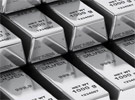 Platinum is a chemical element with symbol Pt and atomic number 78. It is dense, malleable, ductile, highly unreactive, precious, gray-white transition metal. Its name is derived from the Spanish term platina, translated into "little silver".
Platinum is a member of the platinum group of elements and group 10 of the periodic table of elements. It has six naturally occurring isotopes. It is one of the rarer elements in Earth's crust with an average abundance of approximately 5kg. It occurs in some nickel and copper ores along with some native deposits, mostly in South Africa, which accounts for 80% of the world production. Because of its scarcity in Earth's crust, only a few hundred tones are produced annually, and given its important uses, it is highly valuable and is a major precious metal commodity.
Platinum is a chemical element with symbol Pt and atomic number 78. It is dense, malleable, ductile, highly unreactive, precious, gray-white transition metal. Its name is derived from the Spanish term platina, translated into "little silver".
Platinum is a member of the platinum group of elements and group 10 of the periodic table of elements. It has six naturally occurring isotopes. It is one of the rarer elements in Earth's crust with an average abundance of approximately 5kg. It occurs in some nickel and copper ores along with some native deposits, mostly in South Africa, which accounts for 80% of the world production. Because of its scarcity in Earth's crust, only a few hundred tones are produced annually, and given its important uses, it is highly valuable and is a major precious metal commodity.
Palladium
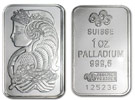 Palladium is a chemical element with symbol Pd and atomic number 46. It is a rare and lustrous silvery-white metal discovered in 1803 by William Hyde Wollaston. He named it after the asteroid Pallas, which was itself named after the epithet of the Greek goddess Athena, acquired by her when she slew Pallas. Palladium, platinum, rhodium, ruthenium, iridium and osmium form a group of elements referred to as the platinum group metals (PGMs). These have similar chemical properties, but palladium has the lowest melting point and is the least dense of them.
More than half the supply of palladium and its congener platinum is used in catalytic converters, which convert as much as 90% of the harmful gases in automobile exhaust (hydrocarbons, carbon monoxide, and nitrogen dioxide) into less noxious substances (nitrogen, carbon dioxide and water vapor). Palladium is also used in electronics, dentistry, medicine, hydrogen purification, chemical applications, groundwater treatment, and jewelry. Palladium is a key component of fuel cells, which react hydrogen with oxygen to produce electricity, heat, and water.
Palladium is a chemical element with symbol Pd and atomic number 46. It is a rare and lustrous silvery-white metal discovered in 1803 by William Hyde Wollaston. He named it after the asteroid Pallas, which was itself named after the epithet of the Greek goddess Athena, acquired by her when she slew Pallas. Palladium, platinum, rhodium, ruthenium, iridium and osmium form a group of elements referred to as the platinum group metals (PGMs). These have similar chemical properties, but palladium has the lowest melting point and is the least dense of them.
More than half the supply of palladium and its congener platinum is used in catalytic converters, which convert as much as 90% of the harmful gases in automobile exhaust (hydrocarbons, carbon monoxide, and nitrogen dioxide) into less noxious substances (nitrogen, carbon dioxide and water vapor). Palladium is also used in electronics, dentistry, medicine, hydrogen purification, chemical applications, groundwater treatment, and jewelry. Palladium is a key component of fuel cells, which react hydrogen with oxygen to produce electricity, heat, and water.
Silver
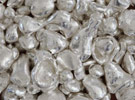 Silver is the metallic element with the atomic number 47. Its symbol is Ag, from the Latin argentum, derived from the Greekὰργὀς (literally "shiny" or "white"), and ultimately from a Proto-Indo-European language root reconstructed as *h2erǵ-, "grey" or "shining". A soft, white, lustrous transition metal, it exhibits the highest electrical conductivity, thermal conductivity, and reflectivity of any metal. The metal is found in the Earth's crust in the pure, free elemental form ("native silver"), as an alloy with gold and other metals, and in minerals such as argentite and chlorargyrite. Most silver is produced as a byproduct of copper, gold, lead, and zinc refining. Silver is more abundant than gold, but it is much less abundant as a native metal. Its purity is typically measured on a per mille basis; a 94%-pure alloy is described as "0.940 fine".
Silver is the metallic element with the atomic number 47. Its symbol is Ag, from the Latin argentum, derived from the Greekὰργὀς (literally "shiny" or "white"), and ultimately from a Proto-Indo-European language root reconstructed as *h2erǵ-, "grey" or "shining". A soft, white, lustrous transition metal, it exhibits the highest electrical conductivity, thermal conductivity, and reflectivity of any metal. The metal is found in the Earth's crust in the pure, free elemental form ("native silver"), as an alloy with gold and other metals, and in minerals such as argentite and chlorargyrite. Most silver is produced as a byproduct of copper, gold, lead, and zinc refining. Silver is more abundant than gold, but it is much less abundant as a native metal. Its purity is typically measured on a per mille basis; a 94%-pure alloy is described as "0.940 fine".
Iridium
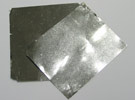 Iridium is a chemical element with symbol Ir and atomic number 77. A very hard, brittle, silvery-white transition metal of the platinum group, iridium is generally credited with being the second densest element (after osmium). It is also the most corrosion-resistant metal, even at temperatures as high as 2000 °C. Although only certain molten salts and halogens are corrosive to solid iridium, finely divided iridium dust is much more reactive and can be flammable.
Iridium was discovered in 1803 among insoluble impurities in natural platinum. Smithson Tennant, the primary discoverer, named iridium for the Greek goddess Iris, personification of the rainbow, because of the striking and diverse colors of its salts. Iridium is one of the rarest elements in Earth's crust, with annual production and consumption of only three tonnes. 191Ir and 193Ir are the only two naturally occurring isotopes of iridium, as well as the only stable isotopes; the latter is the more abundant of the two.
The most important iridium compounds in use are the salts and acids it forms with chlorine, though iridium also forms a number of organometallic compounds used in industrial catalysis, and in research. Iridium metal is employed when high corrosion resistance at high temperatures is needed, as in high-performance spark plugs, crucibles for recrystallization of semiconductors at high temperatures, and electrodes for the production of chlorine in the chloralkali process. Iridium radioisotopes are used in some radioisotope thermoelectric generators.
Iridium is a chemical element with symbol Ir and atomic number 77. A very hard, brittle, silvery-white transition metal of the platinum group, iridium is generally credited with being the second densest element (after osmium). It is also the most corrosion-resistant metal, even at temperatures as high as 2000 °C. Although only certain molten salts and halogens are corrosive to solid iridium, finely divided iridium dust is much more reactive and can be flammable.
Iridium was discovered in 1803 among insoluble impurities in natural platinum. Smithson Tennant, the primary discoverer, named iridium for the Greek goddess Iris, personification of the rainbow, because of the striking and diverse colors of its salts. Iridium is one of the rarest elements in Earth's crust, with annual production and consumption of only three tonnes. 191Ir and 193Ir are the only two naturally occurring isotopes of iridium, as well as the only stable isotopes; the latter is the more abundant of the two.
The most important iridium compounds in use are the salts and acids it forms with chlorine, though iridium also forms a number of organometallic compounds used in industrial catalysis, and in research. Iridium metal is employed when high corrosion resistance at high temperatures is needed, as in high-performance spark plugs, crucibles for recrystallization of semiconductors at high temperatures, and electrodes for the production of chlorine in the chloralkali process. Iridium radioisotopes are used in some radioisotope thermoelectric generators.
Osmium
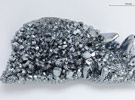 Osmium (from Greek ὀσμή osme, "smell") is a chemical element with symbol Os and atomic number 76. It is a hard, brittle, bluish-white transition metal in the platinum group that is found as a trace element in alloys, mostly in platinum ores. Osmium is the densest naturally occurring element, with a density of 22.59 g/cm3. Its alloys with platinum, iridium, and other platinum-group metals are employed in fountain pen nib tipping, electrical contacts, and other applications where extreme durability and hardness are needed.
Osmium (from Greek ὀσμή osme, "smell") is a chemical element with symbol Os and atomic number 76. It is a hard, brittle, bluish-white transition metal in the platinum group that is found as a trace element in alloys, mostly in platinum ores. Osmium is the densest naturally occurring element, with a density of 22.59 g/cm3. Its alloys with platinum, iridium, and other platinum-group metals are employed in fountain pen nib tipping, electrical contacts, and other applications where extreme durability and hardness are needed.
Rhodium
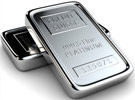 Rhodium is a chemical element with symbol Rh and atomic number 45. It is a rare, silvery-white, hard, and chemically inerttransition metal. It is a member of the platinum group. It has only one naturally occurring isotope, 103Rh. Naturally occurring rhodium is usually found as the free metal, alloyed with similar metals, and rarely as a chemical compound in minerals such as bowieite and rhodplumsite. It is one of the rarest and most valuable precious metals.
Rhodium is a chemical element with symbol Rh and atomic number 45. It is a rare, silvery-white, hard, and chemically inerttransition metal. It is a member of the platinum group. It has only one naturally occurring isotope, 103Rh. Naturally occurring rhodium is usually found as the free metal, alloyed with similar metals, and rarely as a chemical compound in minerals such as bowieite and rhodplumsite. It is one of the rarest and most valuable precious metals.Rhodium is a noble metal, resistant to corrosion, found in platinum or nickel ores together with the other members of the platinum group metals. It was discovered in 1803 by William Hyde Wollaston in one such ore, and named for the rose color of one of its chlorine compounds, produced after it reacted with the powerful acid mixture aqua regia.
The element's major use (approximately 80% of world rhodium production) is as one of the catalysts in the three-way catalytic converters in automobiles. Because rhodium metal is inert against corrosion and most aggressive chemicals, and because of its rarity, rhodium is usually alloyed with platinum or palladium and applied in high-temperature and corrosion-resistive coatings. White gold is often plated with a thin rhodium layer to improve its appearance while sterling silver is often rhodium-plated for tarnish resistance.
Ruthenium
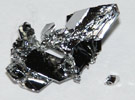 Ruthenium is a chemical element with symbol Ru and atomic number 44. It is a rare transition metal belonging to the platinum group of the periodic table. Like the other metals of the platinum group, ruthenium is inert to most other chemicals. The Baltic German scientist Karl Ernst Claus discovered the element in 1844 and named it after his homeland, the Russian Empire (one of Russia's Latin names is Ruthenia). Ruthenium is usually found as a minor component of platinum ores; the annual production is about 20 tonnes.[5] Most ruthenium produced is used in wear-resistant electrical contacts and thick-film resistors. A minor application for ruthenium is in platinum alloys and as a chemistry catalyst.
Ruthenium is a chemical element with symbol Ru and atomic number 44. It is a rare transition metal belonging to the platinum group of the periodic table. Like the other metals of the platinum group, ruthenium is inert to most other chemicals. The Baltic German scientist Karl Ernst Claus discovered the element in 1844 and named it after his homeland, the Russian Empire (one of Russia's Latin names is Ruthenia). Ruthenium is usually found as a minor component of platinum ores; the annual production is about 20 tonnes.[5] Most ruthenium produced is used in wear-resistant electrical contacts and thick-film resistors. A minor application for ruthenium is in platinum alloys and as a chemistry catalyst.

